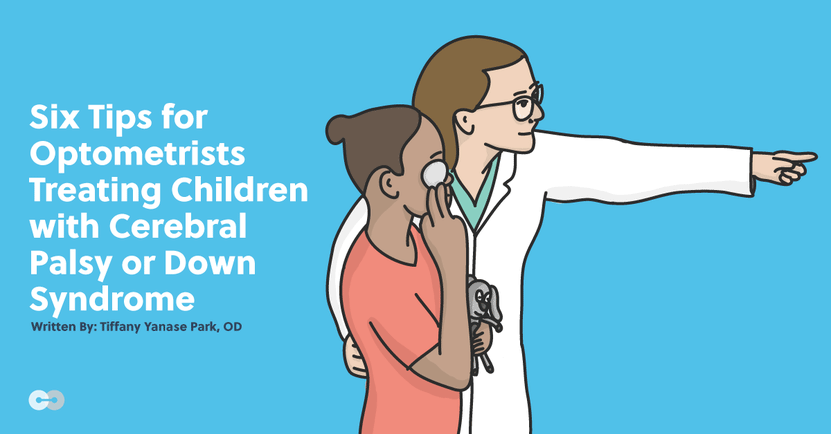Optometrists are key partners in the care of children who have special needs. Many studies confirm that children with various disabilities have a high incidence of vision problems. It is important to distinguish concerns with testability and true visual deficits. Children with autism spectrum disorders and behavioral problems, for example, may have challenges communicating their abilities. Children with Down syndrome and cerebral palsy in particular are at higher risk for eye conditions pernicious to vision development. Despite these general trends, individual children with special needs may have abilities along a large sliding scale. The eye exam may require extra considerations, but our clinical ethos is shared with all patients: excellent and compassionate care.
Objectives
- Understand how to prepare and perform an exam based on a child’s abilities
- Highlight ocular manifestations of Down syndrome and cerebral palsy
Set yourself up for success
Planning for a smooth visit involves several steps even before your patient even comes to the office. Appropriately identify needs during the scheduling process by asking parents a simple question like “does your child have any special needs or accommodations that we should be aware of?”. Also consider asking about a time of day that the patient may cooperate best and invite parents to bring comfort items (i.e. blanket, toy, doll). Generally, allotting
extra time for the first exam can be helpful for children to adjust to their surroundings and to communicate at their own pace.
Exam pearls
Your exam starts the moment you first encounter the family. Carefully observe the child’s overall behavior and any gross motor restrictions to help you tailor the order of your exam and modifications needed. Gauge the child’s activity level and behavior en route to the exam room. Comment on how you like their Marvel T-shirt or ask who they brought with them to their visit: accessible and calm rapport is not only pleasant but also can help accrue the child’s trust throughout the visit.
A good medical and ocular history expands your understanding of the child. Ask the family not only about eye concerns (further explored below), but also about how the child uses their eyes every day. This allows for responses about the range of visual demands, whether it be in school, tablet time, or hobbies. Also understand who else is on the child’s specialist team (ie occupational therapist, speech therapist, physical therapist, behavioral therapist, medical subspecialist, teacher of the visually impaired) to fill in the picture of all of the child’s needs.
The child’s trust and cooperation are two factors that will drive your entire exam. Showing before doing is a sign of respect for the patient’s comfort and expectations. Much of our equipment can appear intimidating to the unfamiliar, imaginative patient (can the transilluminator be a metal eye extraction claw??). When anxiety seems high, model the exam technique first. Shine the penlight to check the child’s doll for an APD or demonstrate LEA symbol matching before it’s the child’s turn. Also, consider giving the patient choices during the exam to increase interest: which colored patch for checking vision? Should we check stereo or color vision first? Which accommodative target friend will be your helper today? Helping the child feel involved in their exam can facilitate good will and fun energy.
When it is the time for the big mission of dilation drops, I am a proponent of honesty. Explain what you are going to do, what it feels like (“shampoo water” is always my go-to) and move swiftly when you get a version of consent from the child or the green light from the parent. Sometimes, the idea alone already prompts a frenzy. However, using the drops after telling the child “it’s just water” can cost you the cooperation needed for the important latter parts of the exam.
What does “done” look like?
The child, the family, and you as the provider may need to agree on an end-point for the examination. In the setting of multiple concerns, you may need more than one visit to get all of the answers. Document successful strategies and triggers to aid you in your next encounter. Your persistence and motivation to obtain reliable data are often refreshing for families seeking longitudinal care.
Considerations for children with Down Syndrome
Down syndrome is the most common chromosomal abnormality and has well documented ocular characteristics.
| Category | Finding | Application/Consideration |
|---|
| Vision | Refractive error (astigmatism, hyperopia) | Cycloplegic refraction |
| Binocularity | Strabismus (esotropia) Accommodative deficit | Cover test or Krimsky Prescribing bifocals |
| Anterior Segment Exam | Prominent epicanthal folds | Pseudo-strabismus |
| Blepharitis | Lid hygiene |
| Nasal-lacrimal duct obstruction | Jones test |
| Keratoconus | Topography, retinoscopy reflex |
| Cataracts | Red reflex |
Considerations for children with cerebral palsy
| Category | Finding | Application/Consideration |
|---|
| Vision | Refractive error | Cycloplegic refraction |
| Binocularity | Strabismus (esotropia) Duction deficits | Cover test or Krimsky EOM, doll's head |
| Fundus exam | Optic nerve pallor | APD |
| Motor limitations | Wheelchair dependence due to muscle paralysis | Portable slit lamp or 20D with pen light |
Children of all abilities may not be able to describe what they see or discern what is considered normal vision. What a full eye examination tells us for a child with disability is no different than the general population: risks for abnormal vision development, need for glasses, and eye diseases. For me, this emphasizes that these children are more alike than different, and it is always our duty as optometrists to deliver outstanding care.
